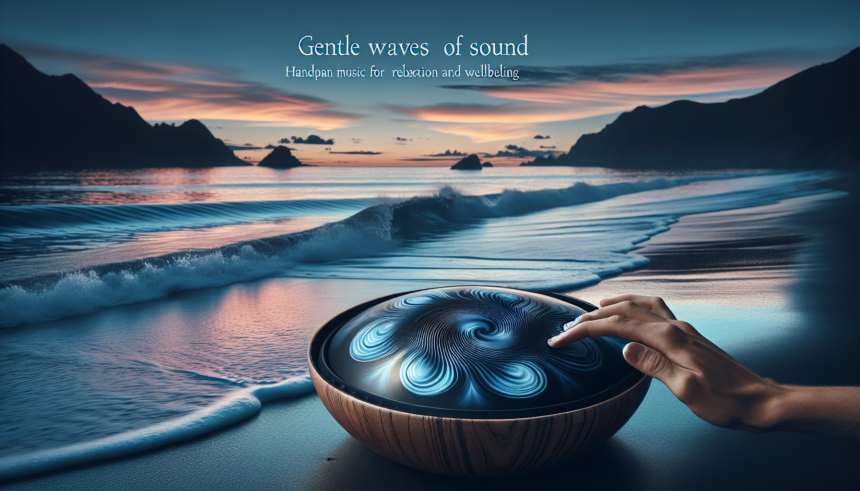<!DOCTYPE html>
<html lang="en">
<head>
<meta charset="UTF-8">
<meta name="viewport" content="width=device-width, initial-scale=1.0">
<title>Gentle Waves of Sound: Handpan Music for Relaxation and Wellbeing</title>
<style>
body {
font-family: Arial, sans-serif;
line-height: 1.6;
color: #333;
margin: 0;
padding: 20px;
}
h1, h2, h3 {
color: #005f5f;
}
p {
margin-top: 0;
}
section {
margin-bottom: 20px;
}
</style>
</head>
<body>
<section>
<h1>Introduction</h1>
<p>The handpan is a relatively new musical instrument that has captured the hearts of many with its ethereal and calming sound. It is a part of the idiophone family, generating music characterized by its harmonic and soothing tones. Originating from the Hang instrument, the handpan has played an integral role in music therapy and is renowned for its relaxation and wellness benefits.</p>
<p>In this article, we will explore the gentle waves of sound produced by the handpan, how it affects our mental and physical well-being, and why it has become an essential tool for relaxation and stress relief.</p>
</section>
<section>
<h2>The Origins and Evolution of the Handpan</h2>
<p>The handpan emerged in the early 21st century when Felix Rohner and Sabina Schärer of Switzerland's PANArt developed the Hang, a steel drum-like instrument. As the Hang gained popularity, other artisans and musicians began creating variations, leading to the evolution of the handpan as we know it today.</p>
<p>Despite its relatively short history, the handpan has rapidly gained a devoted following due to its unique acoustic properties and versatility. Played with the hands, the handpan can produce a wide array of tones, making it a favorite among musicians, therapists, and meditation practitioners alike.</p>
</section>
<section>
<h2>The Acoustic Wonders of the Handpan</h2>
<p>One of the key characteristics of the handpan is its ability to produce sounds that resonate with human emotions. Its melodic, harmonic, and rhythmic nature creates a multi-layered auditory experience that can evoke feelings of tranquility, nostalgia, and introspection.</p>
<p>The handpan's sounds are generated by striking different areas of its concave surface, each with its own specific note. The instrument typically consists of a central note surrounded by a few others, which together form a scale. The thickness of the steel, the precise tuning, and the player's technique all contribute to the handpan's distinctive sound qualities.</p>
</section>
<section>
<h2>Handpan Music and Its Impact on Relaxation</h2>
<p>The calming effects of handpan music are profound, largely due to its harmonic resonances and the rhythmic patterns it creates. Studies have demonstrated that listening to melodious music can lower cortisol levels, reduce heart rate, and facilitate a state of deep relaxation.</p>
<p>When combined with meditation, yoga, or simply as background music, handpan can help alleviate stress, anxiety, and depression by promoting a serene and focused mind. Its gentle rhythms can enhance mindfulness practices, allowing practitioners to enter a state of heightened awareness and inner peace.</p>
</section>
<section>
<h2>Handpan in Music Therapy and Well-being</h2>
<p>Music therapists have found the handpan to be incredibly effective in therapeutic settings. Its soothing soundscapes can be utilized to aid patients with mental health challenges, trauma recovery, and even physical rehabilitation. By focusing on the sensory experience of the music, patients can express emotions non-verbally and articulate feelings that might be difficult to communicate otherwise.</p>
<p>The handpan can also facilitate group therapy sessions, creating a shared experience that encourages communication, empathy, and bonding among participants. Its universal appeal allows it to transcend language and cultural barriers, making it an inclusive tool in therapeutic processes.</p>
</section>
<section>
<h2>Handpan: An Instrument for Personal Exploration</h2>
<p>Beyond its therapeutic applications, the handpan is a great instrument for personal exploration and creativity. Unlike many traditional instruments, the handpan is highly intuitive to play, making it accessible to people of all ages and musical backgrounds.</p>
<p>This allows individuals to engage in a journey of self-discovery through music, exploring new melodies and rhythms without the need for extensive prior training. The improvisational aspect of playing the handpan offers a form of expressive freedom that is both fulfilling and enlightening.</p>
</section>
<section>
<h2>Handpan Music in the Digital Age</h2>
<p>With the advent of digital technology, handpan music has found new platforms for its expansion. Online streaming services, social media, and digital recordings have provided a widespread audience for handpan artists around the globe.</p>
<p>Virtual handpan communities have sprung up, offering enthusiasts a space to share music, techniques, and experiences. This online presence not only fosters a sense of belonging among players but also serves as a rich resource for those looking to incorporate handpan music into their lives.</p>
</section>
<section>
<h2>Conclusion</h2>
<p>The handpan, with its unique soundscapes, has established itself as an instrument of peace, introspection, and creativity. Its gentle waves of sound provide more than just auditory pleasure; they offer a holistic approach to well-being and personal growth.</p>
<p>Whether used in music therapy, relaxation practices, or personal exploration, the handpan continues to touch the hearts of many, encouraging a deeper connection to oneself and the world around us. In a time where stress and anxiety appear more prevalent than ever, the handpan emerges as a beacon of serenity and solace.</p>
</section>
<section>
<h2>Frequently Asked Questions</h2>
<h3>1. Is the handpan difficult to learn?</h3>
<p>The handpan is noted for its intuitive playing style. Unlike more traditional instruments, it allows beginners to create beautiful sounds without extensive formal training, which can make the learning process enjoyable.</p>
<h3>2. How does handpan music benefit mental health?</h3>
<p>Handpan music can help lower stress and anxiety levels. Its harmonious sounds promote relaxation and can be used in mindfulness and meditation practices to support mental well-being.</p>
<h3>3. Can handpan music be used in yoga practices?</h3>
<p>Yes, handpan music is an excellent accompaniment for yoga due to its calming and rhythmic qualities. It can enhance the experience by providing a serene backdrop that assists in attaining focus and relaxation.</p>
<h3>4. Is the handpan used in group therapy sessions?</h3>
<p>Handpan is indeed used in group therapy settings. Its universal appeal helps bridge communication among participants, creating a shared emotive experience that can aid in empathy and bonding.</p>
<h3>5. Where can I find handpan music online?</h3>
<p>Handpan music is widely available on streaming platforms like Spotify, Apple Music, and YouTube. There are also dedicated websites and online communities where you can discover new artists and explore more about the handpan.</p>
</section>
</body>
</html>Gentle Waves of Sound: Handpan Music for Relaxation and Wellbeing

Leave a comment




